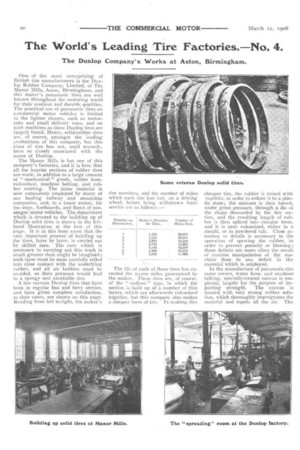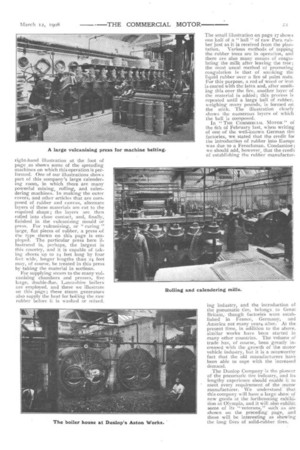The World's Leading Tire Factories. No. 4.
Page 22

Page 23

If you've noticed an error in this article please click here to report it so we can fix it.
The Dunlop Company s Works at Aston, Birmingham,
One of the most enterprising of British tire manufacturers is the Dunlop Rubber Company, Limited, of The Manor Mills, Aston, Birmingham, and this maker's pneumatic tires are well known throughout the motoring world for their resilient and durable qualities. The practical use of pneumatic tires on commercial motor vehicles is limited to the lighter classes, such as motorcabs and small delivery vans, and on such machines as these Dunlop tires are largely found. Heavy, solid-rubber tires are, of course, amongst the leading productions of this company, but this class of tire has not, until recently, been so closely associated with the name of Dunlop.
The Manor Mills is but one of this company's factories, and it is here that all the heavier sections of rubber tires are made, in addition to a large amount of " mechanical " goods, rubber hose, vulcanised, machine belting, and rubber matting The latter material is now extensively employed by many of our leading railway and steamship companies, and, to a lesser extent, for the steps, footboards, and floors of pas.. senger motor vehicles. The department which is devoted to the building up of Dunlop solid tires is shown in the lefthand illustration at the foot of this page. It is in this busy room that the very important process of building up the tires, layer by layer, is carried out by skilled men. The care which is necessary in carrying out this work is much greater than might be imagined ; each layer must be most carefully rolled into close contact with the underlying rubber, and all air bubbles must be avoided, as their presence would lead to a spongy and unreliable tire.
A few veteran Dunlop tires that have been in regular bus and lorry service, and have given complete satisfaction, to their users, are shown on this page. Reading from left tc.}right, the maker's tire numbers, and the number of miles which each tire has run, on a driving wheel, before being withdrawn from service are as follows :—
The life of each of these tires has exceeded the lo,000 miles guaranteed by the maker. These tires are, of course, of the " endless " type, in which the section is built up of a number of thin layers, which are afterwards vulcanised together, but this company also makes a cheaper form of tire. In making this cheaper tire, the rubber is mixed with naphtha, in order to reduce it to a plastic state; the mixture is then forced, under great pressure, through a die of the shape demanded by the tire section, and the resulting length of rubber is then spliced into circular forin, and it is next vulcanised, either in a mould, or in powdered talc. Close attention to details is necessary in the operation of spewing the rubber, in order to prevent porosity or blowing; these defects are more often the result of careless manipulation of the machine than to any defect in the material which is employed.
In the manufacture of pneumatic-tire outer covers, water hose, and machine belting, specially-treated canvas is employed, largely for the purpose of imparting strength. The canvas is treated with very strong rubber solution, which thoroughly impregnates the material and expels all the air. The
right-hand illustration at the foot of page 20 shows some of the spreading machines on which thisctperation is performed. One of our illustrations shows part of this company's large calendering room, in which there are many powerful mixing, rolling, and eatendering machines. In making the outer covers, and other articles that are composed of rubber and canvas, alternate layers of these materials are cut to the required shape ; the layers are then rolled into close contact, and, finally, finished in the vulcanising mould or press. For vulcanising, or " curing " large, fiat pieces of rubber, a press of the type shown on this page is employed. The particular press here illustrated is, perhaps, the largest in this country, and it is capable of taking sheets up to 24 feet long by four feet wide, longer lengths than 24 feet may, of course, be treated in this press by taking the material in sections.
For supplying steam to the many vulcanising chambers and presses, five large, double-flue, Lancashire boilers are employed, and these we illustrate on this page; these steam generators also supply the heat for boiling the raw rubber before it is washed or mixed. The small illustration on page 17 shows one half of a "ball " of raw Para rubber just as it is received from the plan tation. Various methods of tapping the-rubber trees are in operation, and there are also many means of coagulating the milk after leaving the tree ; the most usual method of promoting coagulation is that of smoking the liquid rubber over a fire of palm nuts. For this purpose, a rod of wood or iron is coated with the latex and, after smoking this over the fire, another layer of the material is added ; this process is repeated until a large ball of rubber, weighing many pounds, is formed on the stick. The illustration clearly shows the numerous layers of which the ball is composed.
In" THE COMMERCIAL MOTOR" of the 6th of February last, when writing
of one of the well-known German tire factories, we stated that the credit for the introduction of rubber into Europe was due to a Frenchman, Condamine; we should add, however, that the credit of establishing the rubber manufactur ing industry, and the introduction of the pneumatic tire, belongs to Great Britain, though factories were established in France, Germany, and America not many years after: At the present time, in addition to the above, similar works have been started in many other countries. The volume of trade has, of course, been greatly increased with the growth of the motor vehicle industry, but it is a noteworthy fact that the old manufacturers have been able to cope with the increased demand.
The Dunlop Company is the pioneer of the pneumatic tire industry, and its lengthy experience should enable it to meet every requirement of the motor manufacturer. We Understand. that this company will have a large shOw of new goods at the forthcoming exhibition at Olympia, and it Will also exhibit. some of its "veterans," such as are shown on the preceding page, and these will be interesting as shoWing the long lives of solid-rubber tires.


























